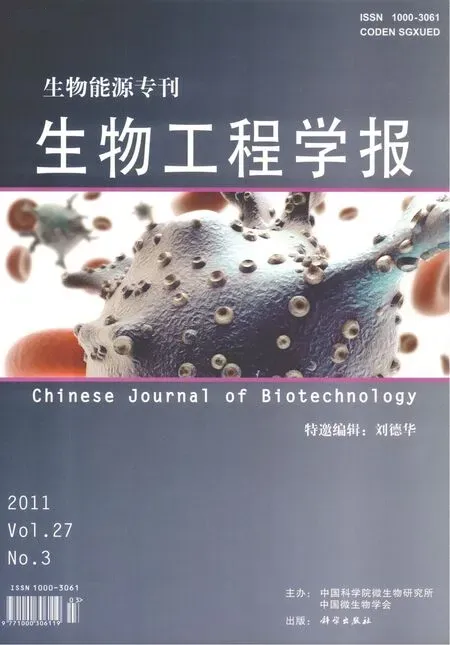2,3-丁二醇生产菌株生产能力的比较和培养基优化
2011-09-29宋源泉吴如春许赟珍范明刘德华
宋源泉,吴如春,2,许赟珍,范明,3,刘德华
1 清华大学化学工程系应用化学研究所,北京 100084
2 广西民族大学化学与生态工程学院 化学与生物转化过程新技术广西高校重点实验室,南宁 530006
3 湖南农业大学应用化学系,长沙 410128
2,3-丁二醇生产菌株生产能力的比较和培养基优化
宋源泉1,吴如春1,2,许赟珍1,范明1,3,刘德华1
1 清华大学化学工程系应用化学研究所,北京 100084
2 广西民族大学化学与生态工程学院 化学与生物转化过程新技术广西高校重点实验室,南宁 530006
3 湖南农业大学应用化学系,长沙 410128
对5株克雷伯氏肺炎杆菌 (包括两株乳酸途径被敲除的工程菌株) 发酵生产2,3-丁二醇能力进行了比较,其中K. pneumonia HR521 LDH (乳酸合成途径中ldhA基因被敲除) 具有最佳的发酵性能。通过正交试验优化了其发酵培养基的主要组分,优化后的培养基组成为:葡萄糖 90 g/L,(NH4)2HPO43 g/L,玉米浆 (CLSP) 6 g/L,乙酸钠 5 g/L,KCl 0.4 g/L,MgSO40.1 g/L,FeSO4·7H2O 0.02 g/L,MnSO40.01 g/L。在优化后的发酵培养基中进行摇瓶发酵,24 h发酵乙偶姻和2,3-丁二醇的终浓度为37.46 g/L,比未优化前增加了10 g/L,2,3-丁二醇得率达到了理论得率的90.53%,生产强度1.56 g/(L·h),检测不到副产物乳酸的生成,利于后提取工艺的进行和工业生产的应用。
2,3-丁二醇,克雷伯氏肺炎杆菌,发酵
Abstract:Five Klebsiella pneumonia strains (including two strains whose genes for lactic acid were knocked out) were used to produce 2,3-butanediol, in which K. pneumonia HR521 LDH (gene for lactic acid was knocked out) was the best for the production,and then the fermentation medium was optimized by orthogonal design. The optimum compositions were as follows: glucose 90 g/L,(NH4)2HPO43 g/L, CLSP 6 g/L, sodium acetate 5 g/L, KCl 0.4 g/L, MgSO40.1 g/L, FeSO4·7H2O 0.02 g/L, MnSO40.01 g/L. Under the above conditions, final concentration of acetone and 2,3-butanediol could reach 37.46 g/L, 10 g/L higher than that under the initial conditions, the yield was 90.53% of the theory, and the productivity was 1.5 g/(L·h), and no lactic acid was detected, which could be benefit for the downstream processing and industrial application.
Keywords:2,3-Butanediol, Klebsiella pneumonia, fermentation
2,3-丁二醇 (CH3CHOHCHOHCH3,2,3-Butanediol,2,3-BDO) 在常温下是一种无色、无臭的透明液体[1-2],分子中含有两个手性碳原子,存在3种旋光异构体,分别是 D-(-)-2,3-丁二醇、L-(+)-2,3-丁二醇和meso-2,3-丁二醇[3],作为一种大宗化学品(<1 $/kg),广泛应用于化工、食品、燃料、航空航天等领域,是石油替代战略中的重要平台化合物,本身可以作为燃料[4-6]、抗冻剂[7]、风味添加剂[8-9]等,还可用来制备聚合物、油墨、香水、熏蒸剂、增湿剂和软化剂、增塑剂、炸药以及药物的手性载体等[2,5,10-11]。鉴于 2,3-丁二醇具有广泛的应用,近年来国内外学者开展了大量的研究工作并获得了较高的 2,3-丁二醇产量[12-13]。
本文以葡萄糖为碳源,比较了 5株克雷伯氏肺炎杆菌发酵生产 2,3-丁二醇的性能,选出其中高产2,3-丁二醇的菌株,并对发酵培养基成分进行了优化。
1 材料与方法
1.1 菌株
实验用克雷伯氏肺炎杆菌Klebsiella pneumoniae 5株,由清华大学化工系应用化学研究所分离并保藏,分别命名为 K. pneumoniae AC01,K. pneumonia HR521,K. pneumonia HR521 LDH (乳酸合成途径中的基因ldhA被敲除),K. pneumonia HR526,K. pneumonia HR526 LDH (乳酸合成途径中的基因ldhA被敲除)。
乳酸途径缺失菌株的构建:在 K. pneumonia HR521和HR526在发酵生产的过程中会产生乳酸,分流碳源,不利于目的产物的积累和后提取工作的开展。经检测,产生的乳酸以D型乳酸为主,通过敲除D型乳酸的关键表达基因ldhA可以有效地降低乳酸的产量,提高目的产物得率。具体敲除过程如下,首先,以K. pneumonia HR521或526总DNA为模板,正向引物序列为 5′-GGAATTCACGGTTG CGAACGGTATGTA-3′,反向引物序列为 5′-GCTC TAGAAGTGGTCTCCGAAATGCTGA-3′ (引物序列中包含EcoRⅠ和XbaⅠ限制性酶切位点),进行PCR(聚合酶链式反应) 扩增获得ldhA部分基因。将PCR获得的ldhA部分基因连接到pMD18-T simple 载体质粒,获得pMD-ldh质粒并测序。扩增此质粒,然后使用EcoRⅠ和XbaⅠ进行双酶切,获得的ldhA基因片段连接到pGPCm自杀载体,得到的pGPCm-ldh使用冻融法导入到E. coli SM10中获得重组菌。此重组菌作为供体与K. pneumonia HR521或526进行接合转化,然后通过氯霉素 (来自 pGPCm-ldh) 和氨苄 (来自K. pneumonia HR521或526) 双抗性筛选获得目的菌株K. pneumonia HR521或526 LDH。
1.2 培养基和培养方法
斜面培养基和种子培养基组成和培养方法参照文献[13]。
发酵培养基(g/L):葡萄糖 70,玉米浆 (CSLP)8,(NH4)2HPO45,无水乙酸钠 3,KCl 0.4,MgSO40.1,FeSO4·7H2O 0.02,MnSO40.01,pH 7. 0,115 ℃灭菌15 min。
发酵培养条件:按 2%的接种量将种子液转接到装有100 mL发酵培养基的250 mL摇瓶中,接种后的摇瓶于37 ℃摇床培养,转速150 r/min。
1.3 分析方法
生物量细胞干重 (DCW):通过722S分光光度计在波长600 nm下测定,根据干重与OD600对应的标准曲线计算。
底物及代谢产物的检测:发酵底物及代谢产物使用SHIMADZU高效液相色谱(日本岛津公司),色谱柱为Aminex resin-based 87H柱,柱温65 ℃,流动相为0.005 mol/L H2SO4,流速0.8 mL/min,检测器为CTO.10vp折光示差检测器,进样量为20 µL。
1.4 培养基优化正交试验设计
采用L9(34) 正交表安排实验,考察了葡萄糖、CSLP、(NH4)2HPO4和乙酸钠浓度对发酵性能的影响,其他发酵组分浓度保持不变。
2 结果与分析
2.1 不同克雷伯氏肺炎杆菌菌株发酵生产 2,3-丁二醇的比较
实验菌株为本实验室现有的 5株克雷伯氏肺炎杆菌发酵条件为37 ℃,150 r/min,发酵时间24 h,进行4组平行,2,3-丁二醇和主要副产物浓度如表 1所示。野生菌中,发酵生产 2,3-丁二醇最优菌株为HR521,然后是HR526,相对较差的菌株是AC01;乳酸合成途径被敲除后,2,3-丁二醇的产量大大提高,亦即HR521 LDH和HR526 LDH发酵生产 2,3-丁二醇能够得到更高的产量,并且没有副产物乳酸的产生。5株菌中,HR521 LDH发酵生产2,3-丁二醇具有最佳的效果,副产物较少,检测不到乳酸的生成,是比较理想的菌株。
2.2 培养基优化结果
正交试验结果如表 2所示,各因素对发酵影响大小的顺序依次为葡萄糖>(NH4)2HPO4>CSLP>乙酸钠,各因素效应曲线如图1所示,最终确定的发酵组成为:葡萄糖 90 g/L,(NH4)2HPO43 g/L,CSLP 6 g/L,乙酸钠5 g/L。
2.3 最优培养基验证
按照优化的发酵培养基组成进行 K. pneumonia HR521 LDH发酵生产2,3-丁二醇,共进行3组平行,24 h发酵结果表3所示。目的产物的终浓度较未优化前增加了 10 g/L,整个发酵过程的二醇得率达到了理论得率的90.53%,生产强度1.56 g/(L·h),检测不到乳酸的生成,主要副产物为乙醇,利于产物的后提取。

表1 5株克雷伯氏肺炎杆菌发酵生产2,3-丁二醇的比较Table 1 Comparison of 5 different K. pneumonia strains to produce 2,3-butanediol

表2 K. pneumonia HR521 LDH 2,3-丁二醇发酵正交试验结果Table 2 2,3-Butanediol fermentation with K. pneumonia HR521 LDH on orthogonal design

图1 正交试验各因素效应曲线Fig. 1 Effect curves of the factors on orthogonal design.

表3 K. pneumoniae HR521 LDH优化培养基发酵Table 3 2,3-Butanediol fermentation by K. pneumoniae HR521 LDH on the optimized medium
3 结论
本实验中的 5株克雷伯氏肺炎杆菌均具有发酵生产2,3-丁二醇的能力,其中K. pneumonia HR521 LDH性能最佳,在优化后的培养基中发酵,目的产物浓度可高达37.46 g/L,得率达理论值的90.53%,并且检测不到乳酸副产物的生成,在一定程度上减少了后提取的工艺操作单元,降低了后提取的成本,具有一定的工业应用前景。
REFERENCES
[1] Magee RJ, Kosaric N. The microbial production of 2,3-butanediol. Adv Appl Microbiol, 1987, 32(1): 89−161.
[2] Syu MJ. Biological production of 2,3-butanediol. Appl Microbiol Biotechnol, 2001, 55(1): 10−18.
[3] Zhang LY. Research on 2,3-butanediol production by Serratia marcescens H30 and its metabolic regulation[D].Shanghai: East China University of Science and Technology, 2010.
张燎原. 粘质沙雷氏菌发酵生产 2,3-丁二醇及其代谢调控研究[D]. 上海: 华东理工大学, 2010.
[4] Flichinger MC. Current biological research in conversion of cellulosic carbohydrates into liquidfuels: how far have we come. Biotechnol Bioeng, 1980, 22(Suppl 1): 27−48.
[5] Garg SK, Jain A. Fermentative production of 2,3-butanediol:a review. Bioresource Technol, 1995, 51(2/3): 103−109.
[6] Yu EC, Levitin N, Saddler JN. Production of 2,3-butanediol by Klebsiella pneumoniae grown on acid hydrolyzed wood hemicelluslose. Biotechnol Lett, 1982, 4(11): 741−746.
[7] Soltys KA, Batta AK, Koneru B. Successful nonfreezing,subzero preservation of rat liver with 2,3-butanediol and type I antifreeze protein. J Surg Res, 2001, 96(1): 30−34.
[8] Romano P, Granchi L, Caruso M, et al. The speciesspecific ratios of 2,3-butanediol and acetoin isomers as a tool to evaluate wine yeast performance. Int J Food Mircobiol, 2003, 86(1/2): 163−168.
[9] Bartowsky EJ, Henschke PA. The ‘buttery’ attritute of win-diacetyl-desirability, spoilage and beyond. Int J Food Microbiol, 2004, 96(3): 235−252.
[10] Xiu ZL, Zeng AP. Present state and perspective of downstream processing of biologically produced 1,3-propanediol and 2,3-butanediol. Appl Microbiol Biotechnol, 2008, 78(6): 917−926.
[11] Celińska E, Grajek W. Biotechnological production of 2,3-butanediol-current state and prospects. Biotechnol Adv, 2009, 27(6): 715−725.
[12] Zhang LY, Sun JA, Hao YL, et al. Microbial production of 2,3-butanediol by a surfactant (serrawettin)-deficient mutant of Serratia marcescens H30. J Ind Microbial Biotechnol, 2010, 37(8): 857−862.
[13] Ma CQ, Wang AL, Qin JY, et al. Enhanced 2,3-butanediol production by Klebsiella pneumoniae SDM. Appl Microbiol Biotechnol, 2009, 82(1): 49−57.gilvosporeus by response surface methodology. J Chem Eng Chin Univ, 2006, 20(1): 68−73.
骆健美, 金志华, 岑沛霖. 褐黄孢链霉菌纳他霉素发酵条件优化. 高校化学工程学报, 2006, 20(1): 68−73.
[14] Shen XL, Xia LM. Production and immobilization of cellobiase from Aspergillus niger ZU207. Process Biochem, 2004, 39: 1363−1367.
[15] Chen M, Xia LM, Xue PJ. Enzymatic hydrolysis of corncob and ethanol production from cellulosic hydrolysate. Int Biodeterior Biodegrad, 2007, 59: 85−89.
[16] Xu XP, Yuan SF, Liu LM. Optimization of culture medium for producing high β-glucosidase by Aspergillus niger mutant. J Food Sci Biotechnol, 2008, 27(5): 124−127.
许晓鹏, 袁士芳, 刘立明. 突变黑曲霉高产 β-葡萄糖苷酶的培养基优化. 食品与生物技术学报, 2008, 27(5):124−127.
[17] Tian YH, Zhang X, Li DY, et al. Study on the optimization of the fermentation medium of β-glucosidase produced by Aspergillus niger. Liquor-Making Sci Technol, 2010(3):20−23.
田毅红, 张鑫, 李德莹, 等. 黑曲霉产 β-葡萄糖苷酶培养基的优化研究. 酿酒科技, 2010(3): 20−23.
Comparison of 2,3-butanediol production by several strains and optimization of the fermentation medium
Yuanquan Song1, Ruchun Wu1,2, Yunzhen Xu1, Ming Fan1,3, and Dehua Liu1
1 Institute of Applied Chemistry, Department of Chemical Engineering, Tsinghua University, Beijing 100084, China
2 College of Chemistry and Ecological Engineering, Guangxi University for Nationalities, Key Laboratory of Chemical and Biological Transforming Process, Nanning 530006, China
3 Department of Applied Chemistry, Hunan Agricultural University, Changsha 410128, China
Received: November 23, 2010; Accepted: February 16, 2011
Corresponding author: Dehua Liu. Tel: +86-10-62794742; E-mail: dhliu@tsinghua.edu.cn
